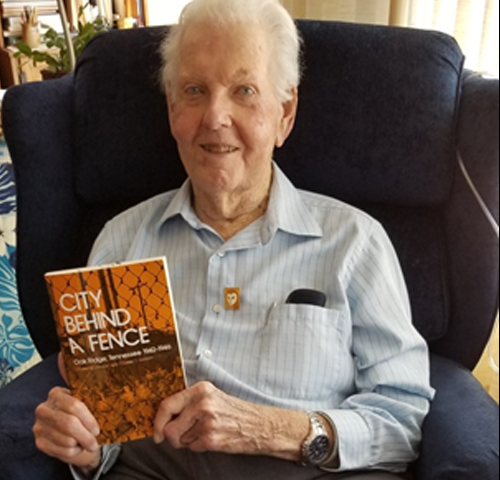Oak Ridge During World War II-a First-Hand Perspective
In my ongoing efforts to discover and share interesting stories about the World War II era, I had rare encounter. I got to interview one of the mechanical engineers who worked at the “city behind the fence.” His daughter and I are members of the same professional women’s group in the Bay area and at a summer retreat, we made a surprising discovering. Her father had worked in one of the plants at Oak Ridge, Tennessee, just twenty-eight miles from where I grew up. In fact, he was assigned to the Y-12 plant where most of U-235, the fuel for the first atomic bomb, was produced. That bomb ended the war and brought my father and many other soldiers home.
I had never met anyone who worked in Oak Ridge during the war, so I was eager to connect with him and learn about his experiences. However, it would take several years and many logistics to make that happen. I am indeed grateful that we finally met. Thank you, Richard Cook for sharing your story.
Richard, who was born in New Jersey in 1922 started his mechanical engineering program at Cornell but was drafted before he could finish his studies. When he completed his basic training program, he was sent to a special school in Nebraska to further enhance his engineering skills. Afterwards, he was sent to Minnesota for more specialized training. Yet, he had no idea why he was getting this advanced engineering education. When it was completed, he and several other young recruits were asked, “Would you be interested in working on a secret war project?” Without hesitation he said, “Yes.”
I was curious about Richard’s quick response and why he had so easily agreed.
“Adventure!” he said. “I was a young man and open to new experiences. I was eager to explore the world.”
Even though he did not know what world awaited him, he still agreed. There were few details about this assignment, except that it was not overseas. He did not know where he was going; only that he could not leave once his work began.
In 1944 the real adventure began. On a Friday he married his sweetheart in Minnesota, and on Monday he boarded a bus to Knoxville, Tennessee. His wife could not come with him since she was still completing several nursing degrees. However, she would eventually join him and work at Knoxville General Hospital.
When he and the other new engineer recruits arrived in Knoxville, they were met by army officials and boarded another bus. Twenty-five miles away was his final destination, the site of the Clinton Engineer Works. This former rural farm county was booming with new construction projects, housing developments and auxiliary services which would soon support 75,000 residents. But there were incredible challenges when they arrived: lack of adequate housing, rivers of mud and constant equipment breakdowns. The conditions were indeed primitive.
He experienced all of this first-hand. His initial housing was a cramped Quonset hut shared with other engineers. They didn’t own a car, and the unpaved roads were often impassable due to frequent rains and flowing mud. Transportation was a constant struggle so most people used the reliable bus services to enter the secured area and to travel within its confines. During those war years the Oak Ridge transit became the sixth largest bus operation in the United States.
He had vivid memories about their working conditions. “There were three shifts with the constant coming and going of the workers. It was very hectic but not oppressive. We felt an exceptional sense of comradery. We knew we had to win the war and that meant keeping the Y-12 calutrons operating around the clock. Every day we had to solve the equipment’s mechanical problems-the most trying aspect of our work. We did feel the pressure.”
I didn’t realize the scale of this work until I researched Y-12, the electromagnetic separation plant where he was assigned. The entire operation covered over 811 acres. There were two separate calutron buildings, plus cooling towers, chemical processing plants, pump houses and steam plants for this project alone. It was first estimated that 2,500 workers were needed to maintain the operations. Yet, the year after Richard was hired, there would be more than 5,000 workers at that plant and that number would continue to increase.
I was also curious about the extreme measures employed to maintain secrecy at Oak Ridge and asked Richard if this was true. “Absolutely! Our manager would meet with us regularly to reinforce the protocol of keeping quiet and the consequences if we didn’t. They frequently changed our shifts to ensure that we didn’t work with the same people. We never talked about our work with anyone even our coworkers who lived in our apartment building. We knew better. I even had a friend who was trained to serve as a spy. I never knew the real purpose of my work except that it supported the war effort and was somehow dealing with atoms. Even after the war, we were still under a code of silence. In fact, I have a copy of a post-war letter that reminded me that I still could not talk about my work at Oak Ridge.”
As our conversation was ending, he shared a couple of funny stories about living there. His father had helped him buy a car for his commute from Knoxville, but it also served another unlikely social role. Knox County was “dry” so you could not buy liquor, but there were no restrictions in nearby Loudon County. Often his car became a “booze transport” for his buddies, and those refreshments meant a lot to his colleagues who were working around the clock and under constant surveillance. This ninety-five year old former Oak Ridge engineer told that story with a twinkle in his eye.
Then he remembered another funny incident involving First Lady Eleanor Roosevelt who tried to leave the secure area through the wrong gate. She had visited Oak Ridge as a speaker at the local American Association of University Women event, but her entourage somehow took her to the wrong exit and caused a big uproar. That incident made a big impression, and locals realized that even the First Lady must follow the rules!
After the war, Richard received his honorable discharge at Fort McPherson, Atlanta, and left immediately for the east coast to complete his engineering degree at Cornell. Upon graduation, he and his wife settled in Providence, Rhode Island, where he began working at Darlington Fabrics. They eventually had two children and they stayed in that area throughout his successful career in the textile industry.
Even though he had returned to the east coast after the war, he never forgot about his time in Oak Ridge and stayed in touch with members of his working group. Some fifty years later, he and his fellow engineers visited Oak Ridge for the first time.
“What was it like then?” I asked.
“It was very different from when I was there.” He then laughed and said, “The mud was gone!”
Richard now lives in Oakland, California, near his only daughter but his interest in that time period has not waned. He and his daughter read and discuss the latest books about that historic time and place. I was happy that I could introduce him to a recent find, City Behind a Fence, Oak Ridge, Tennessee 1942-46. I had discovered this book at the Oak Ridge Museum, but I never expected to share it with someone who had actually lived there then.
Our conversation ended much too soon. What a gift it was to talk to this remarkable man who had played such an important role in helping end World War II seventy-two years ago.





2 Comments
Amazing story, Jenny. Thank you for sharing.
I love this article! What a wonderful interview with such an incredible man. Thank you for taking the time to share this story.